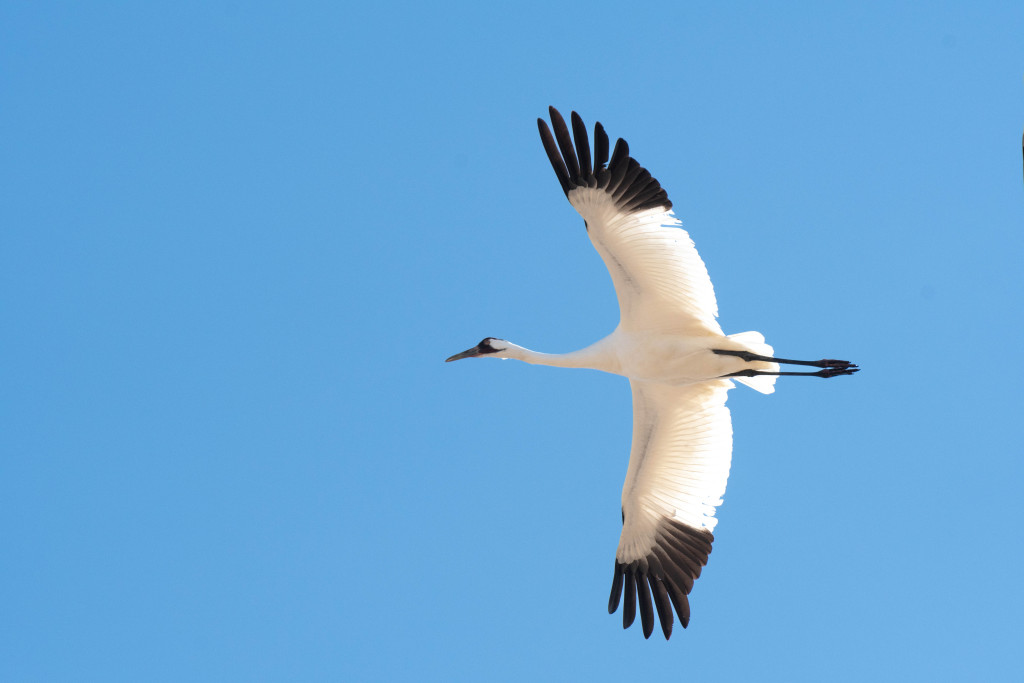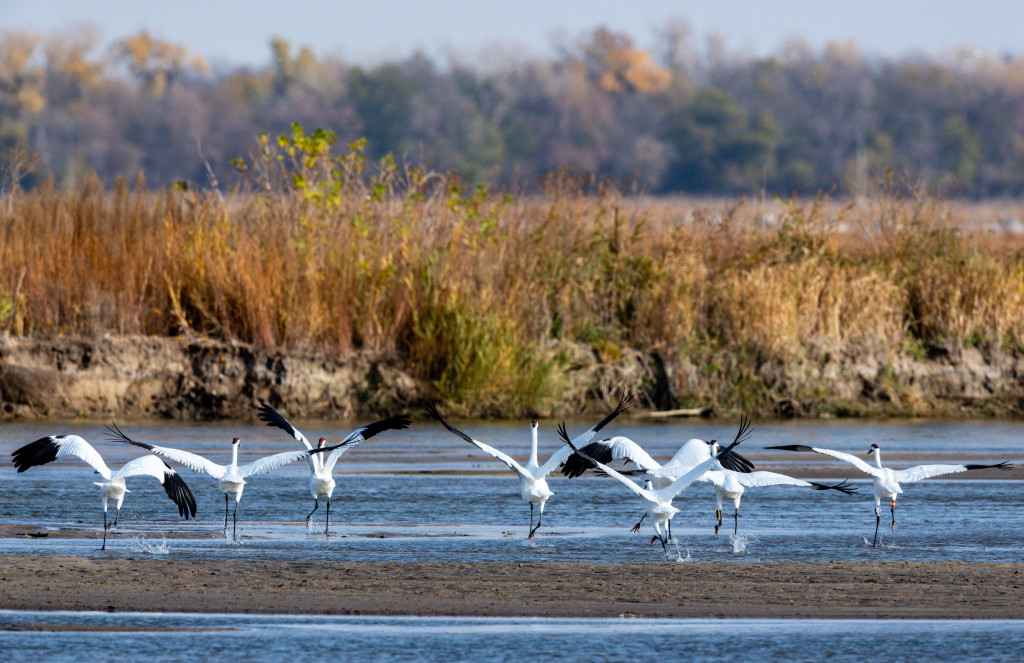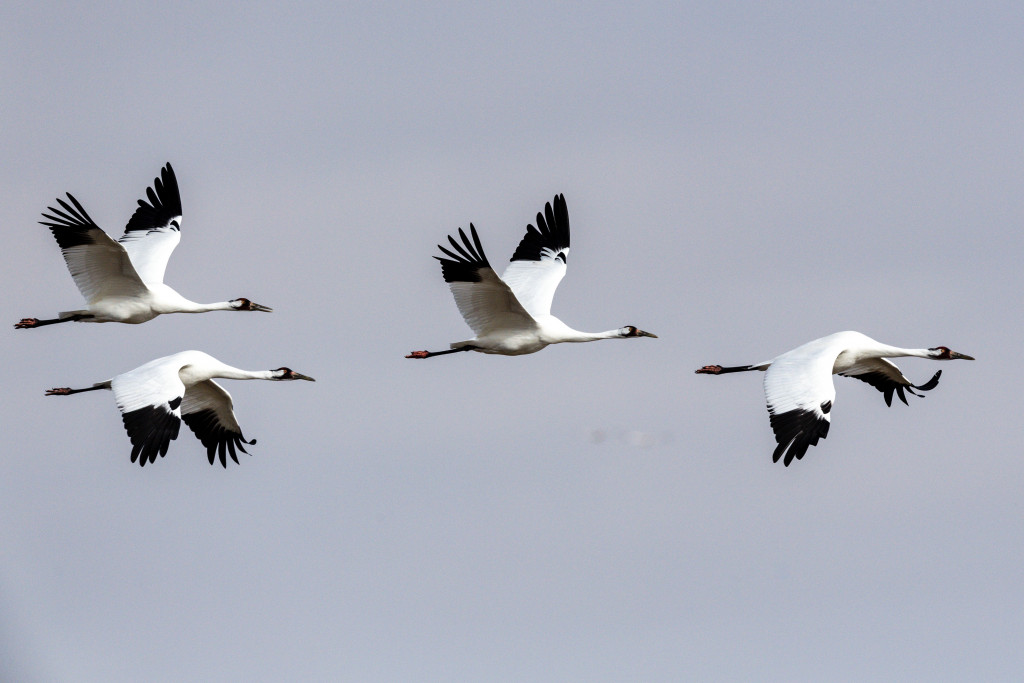The recovery of whooping crane populations is an on-going, collaborative effort across multiple states, countries and conservation groups.
Enlarge

Photo by Eric Fowler, Nebraskaland Magazine
By Olivia DaRugna, Wildlife Diversity Biologist
Whooping Cranes are one of the rarest birds in the world. In the 1940s, whooping cranes declined to fewer than two dozen individuals due to unregulated shooting and loss of nesting habitat. This drastic decline led to whooping cranes being one of the first species to gain protection under the Endangered Species Act in 1973.
Whopping Crane Conservation
The recovery of whooping crane populations is an on-going, collaborative effort across multiple states, countries and conservation groups. Since listing, the entire population, both wild and in captivity, has grown to more than 700 individuals. The recovery of this species takes lots of time, effort and resources. The birds take a long time to reach sexual maturity, not laying eggs until they are about five years of age. Additionally, they are monogamous, forming life-long pair bonds. During breeding season, both adults care for and protect the eggs and young, typically rearing only one chick per year, if they breed at all.
There are three geographically distinct populations of whooping cranes, two of which are reintroductions. The cranes that stopover in Nebraska to rest and refuel are from the Aransas Wood Buffalo population. This is the only wild, self-sustaining migratory population in existence. They migrate 2,500 miles between their wintering grounds at Aransas National Wildlife Refuge on the Texas coast and their breeding grounds in Wood Buffalo National Park in Alberta, Canada.

in Hall County. Photo by Eric Fowler.
Preliminary data from surveys done by the U.S. Fish and Wildlife Service around the wintering grounds in January indicates around 530 individuals in this population. There were efforts to establish a migratory population that winters in Florida and breeds in Wisconsin, as well as other reintroductions of non-migratory populations near the Gulf Coast. However, no reintroduction has been successful thus far.
Tracking Whooping Cranes in Nebraska
Several agencies, organizations and citizen scientists track whooping cranes statewide during their migration. Part of the tracking efforts includes aerial surveys by the Platte River Recovery Implementation Program each spring and fall. These surveys aim to monitor and understand how the whooping cranes are responding to management efforts in the Platte Valley area. Before sunrise, pilots fly transects over wetlands while trained observers onboard record observations of the whooping cranes. Crews on the ground help confirm the sightings.
Even with aerial surveys and assistance from on-the-ground crews, it can be challenging to search for these federally endangered birds in such a large area. Game and Parks and partner organizations rely on the public to help track where the birds are occurring during their stopovers in Nebraska.
If you see a whooping crane, please report your sighting here: https://outdoornebraska.gov/about/give-back/help-wildlife/community-science/whooping-crane-migration-rename/. Photos are encouraged to be included in your observation submission. However, the cranes should not be approached or harassed to capture the photos. The public is also encouraged to include additional information in their reports, such as location, behavior and if it can be determined, the number of adults and juveniles.
You can also report sightings to Nebraska Game and Parks Commission by calling 402-471-0641

Distinguishing Whooping Cranes
Several species are occasionally mistaken for whooping cranes, including the American white pelican, trumpeter swan, snow goose and Sandhill crane. Whooping cranes stand at about 5 feet tall, and their bright white plumage stands out when next to the gray of Sandhill cranes. In flight, they keep their necks outstretched, long legs extended beyond the tail, and their white plumage contrasts with the black primaries (long flight feathers on the tip of their wings). Read Nongame Bird Program Manger Joel Jorgensen’s story on Distinguishing Whooping Cranes From Other Species for great visuals and tips.
The post At-Risk Species Spotlight – Whooping Crane appeared first on Nebraskaland Magazine.
















